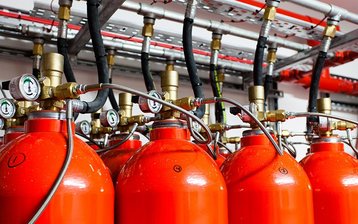Oxygen makes up 21 percent of the atmosphere at Sea Level. OK, so there is no point arguing the toss, OSHA (the US Occupational Safety and Health Administration) says that people can’t work in oxygen levels lower than 19.5 percent and that’s the end of the conversation.
Breathing masks required?
You can use oxygen reduction to prevent fires in for ‘unoccupied’ spaces or areas that are infrequently visited – such as museum archives – but you would have to equip the personnel with oxygen masks etc. In explanation of the 19.5 percent limit OSHA uses quite alarming language:
”Human beings must breathe oxygen … to survive, and begin to suffer adverse health effects when the oxygen level of their breathing air drops below [19.5 percent oxygen]. Below 19.5 percent oxygen … , air is considered oxygen-deficient. At concentrations of 16 to 19.5 percent, workers engaged in any form of exertion can rapidly become symptomatic as their tissues fail to obtain the oxygen necessary to function properly (Rom, W., Environmental and Occupational Medicine, 2nd ed.; Little, Brown; Boston, 1992). Increased breathing rates, accelerated heartbeat, and impaired thinking or coordination occur more quickly in an oxygen-deficient environment. Even a momentary loss of coordination may be devastating to a worker if it occurs while the worker is performing a potentially dangerous activity, such as climbing a ladder. Concentrations of 12 to 16 percent oxygen cause tachypnea (increased breathing rates), tachycardia (accelerated heartbeat), and impaired attention, thinking, and coordination (e.g., Ex. 25-4), even in people who are resting.”
In comparison to the OSHA 19.5 percent limit, oxygen-reduction fire suppression systems, which have distinct advantages in European data centres where (water) sprinklers are generally not fitted, rely on the effect that at 16 percent combustion cannot commence or be sustained.
So, basically, colocation data centres (where traffic is highest) cannot be fitted with oxy-reduct in the USA – unless you provide breathing sets, which is just not going to happen, right? Of course, in the USA sprinklers are the norm, mainly due to building fabric insurance needs, and so gaseous systems are an added luxury instead of the only option as in Europe if you want to avoid water in the room.
OSHA won’t move
But whilst no-one will ever be able to get OSHA to change (you can’t argue against safety legislation without sounding like a Victorian mill owner) it is rather funny to question the detail. So, how about airline crew? Yes, they have access to breathing sets but in normal duty they fly planes often with less than 19.5 percent oxygen levels. Then what about places in the USA like:
-
Alma & Breckenridge, Colorado at higher than 3,160m
-
Brian Head, Utah at 3,000m
-
Taos Valley, New Mexico at 2,841m with some businesses above 3,100m
-
Fox Park, Wyoming at 2,762m
Just to mention a few… all places where ‘Increased breathing rates, accelerated heartbeat, and impaired thinking or coordination occur’ must make it hard to survive, let alone work and play, since at that altitude there is less than the equivalent of 19.5 percent oxygen content. Clearly according to OSHA there can be no hotels, restaurants, taxi drivers, police force, firemen or indeed any other employment in these places?
Whilst OSHA has no jurisdiction outside of the USA we could consider La Paz, capital of Bolivia, at 3,640m and 65 percent of the oxygen level as at Sea Level, or Quito, Ecuador, at 2,850m and 72 percent of the oxygen. Surely these capital cities have workers? This might even explain, if not excuse, Mr Clarkson’s extreme view of Mexicans – Mexico City at 2,240m with its 8.9 million population breathing air that has 77 percent the oxygen content as that at Sea Level. Maybe OSHA has a point about ‘even in people who are resting’….
Anyway there is no legislation in place in Europe but many places advise a limit to working hours and a break pattern so oxy-reduct still offers a solution to those wanting to avoid water and gaseous systems. About now some folks will be screaming ‘acclimatization’ at me, so I’m just off for a cigar - which will reduce my oxygen level dramatically for the next 20 minutes or so!



